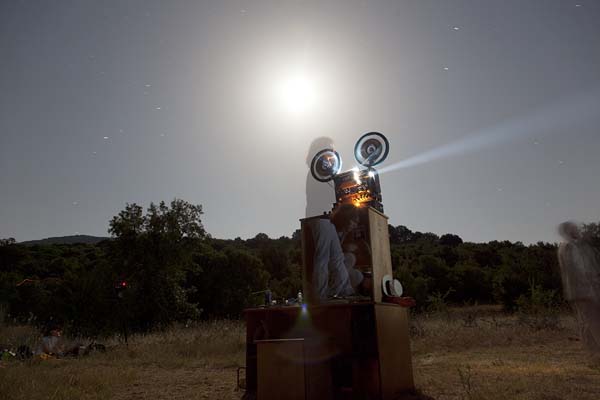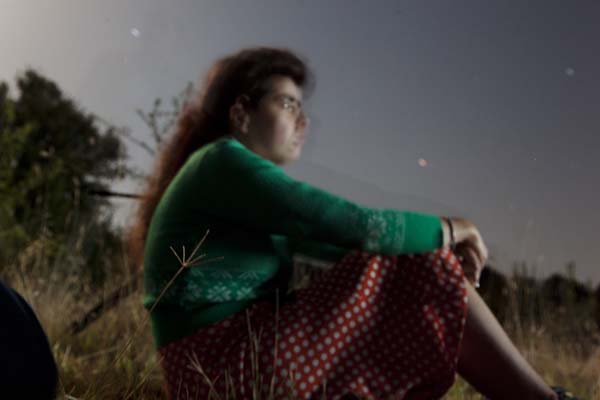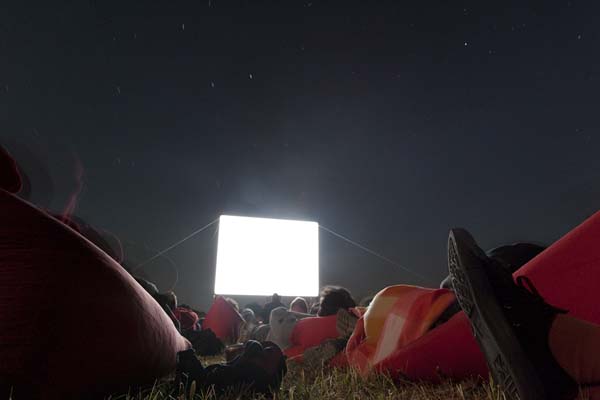Fire in the Sky
"The mental image: it is not retained in the brain, but is, somehow, used as energy; thus, dispersed, sent forth like the effects of the sun. This energy is dispersed both between the Earth (the setting where the being happens to be), and likely beyond. Does this sustain what we call eternity?"—Gregory Markopoulos, 24 December 1988
The American avant-garde filmmaker Gregory Markopoulos (1928–1992) was also a prolific writer. He liked to launch his essay titles with the word towards ("Towards a New Spectator," "Towards the Temenos," "Towards a New Narrative Film Form"), imagining a future for a not-yet-materialized ideal. "Towards" also carried the enormity of his intentions—his regular writing in Jonas Mekas's Film Culture in the 1960s and early 1970s was a kind of place holder for his cinematic vision before it could be realized. He spent the last 10 years of his life re-editing most of his previous films and 55 completely new ones into a silent magnum opus. The 80-hour Eniaios (which means both "unity" and "uniqueness") is composed of 100 individual titles in 22 cycles, or orders, of three to five hours each; it was designed for exclusive outdoor screening in the remote Peloponnese in an event and site he called the Temenos (an ancient Greek word for "sacred grove" or "place set apart").[1] The Temenos represented an opportunity for spectators to encounter the divine potential of cinema away from the distractions of daily life.

Screening of Eniaios
Almost two decades after Markopoulos's death, the future continues to loom large. Eniaios has never been seen in its entirety by anyone. In fact, Markopoulos never saw a single cycle projected; the project was completely edited, but not printed, when he died of cancer. Manifesting his vision became the work of his longtime partner, the filmmaker Robert Beavers (b. 1949), whose films Markopoulos also wished to be presented in Temenos screenings. Since 2004, eight Eniaios cycles have been printed, and two to three cycles have screened at the Temenos location (just outside Lyssaraia, Markopoulos's ancestral village, whose winter population is ten) every four years (in 2004, 2008, and 2012). The cost of printing a single cycle is $20,000 to $25,000 (including internegative stock and answer copy); in addition to fundraising, painstaking repair of thousands of original camera splices in each cycle must precede printing. At the current rate of progress, and assuming the continued availability of the necessary Kodak internegative stock, Eniaios will be fully printed in 2026 or 2030.
The late June 2012 screening of Orders VI–VIII attracted the biggest Temenos audience yet. More than 200 spectators—from the U.S., Canada, the U.K., Norway, Germany, Switzerland, and across Greece—gathered; most stayed in the tiny village of Loutra, known for its therapeutic springs, in the extra bedrooms local residents rent to spa visitors, and about 50 campers slept by the screening site itself. For three consecutive nights, after traveling about 20 km to a mountaintop spot by bus, and then walking another kilometer to a clearing, Temenos attendees arranged themselves on benches and handmade red beanbags. When the sun set, Toronto projectionist Kathryn MacKay inaugurated several hours of screening. Eniaios is composed of brief flashes of image, most only a few frames long; all are separated by segments of clear and black leader. Markopoulos was preoccupied with the unit of the single frame and the still image: "It is, perhaps, a fallacy to believe that film is constant movement," he said.[2]
Despite the unseen status of the full Eniaios, one fact is certain: re-edited portions of Markopoulos's The Iliac Passion, his 1967 interpretation of Prometheus Bound starring Andy Warhol and Jack Smith, appear in all 22 cycles.[3] But even this fact is quickly destabilized by the halo of ambiguity surrounding Prometheus himself. The Titan is best known for the theft of fire for humans; enraged Zeus retaliated by chaining Prometheus to a rock and visiting him daily in the form of a liver-gnawing eagle. But in the version of the story that Markopoulos followed, Aeschylus's Prometheus Bound, Prometheus is enhanced—more powerful and prophetic than the figure Hesiod had earlier rendered, aligned more closely with the gods, the catalyst for human creativity itself. In Aeschylus's hands, Prometheus plays alternately mortal and immortal roles, becomes a potent rebel, a threat to the authoritarian supremacy of Zeus.[4] In the face of the daunting remoteness that characterizes Eniaios—in both geographical and aesthetic terms—thoughts of the porous human-divine border can hover uncomfortably around the idea of the Temenos itself: do attendees flock to Arcadia as worshippers at the filmmaker's temple, as kneelers at the altar of a Promethean Markopoulos? Is meaningful reception of this strange work dependent on familiarity with the reference worlds of the dozens of former films from which Markopoulos sculpted Eniaios?
Prometheus Bound was never meant to be a self-contained unity but one part of a larger superdrama, Prometheia, most of which has been lost. For Aeschylus translator C. John Herington, the dilemma of partialness can be resolved not by deeper scholarship but by the reader's imagination. "The reader has been forced to construct for himself some response to the play's fearsome thesis...where the ancient poem now abandons him...an eternally modern poem begins: his own."[5] The Eniaios spectator encounters a similar quandary—not only in seeing just a fragment of the whole but in the nature of the frame-length flashing images.[6] It's a fitting dilemma, though, since Markopoulos's "towards" also imagined a creative spectator. In his essays he called readers to consciousness, assigning them a central role in the evolution of new forms of cinema. The Temenos vision was undeniably grand, even grandiose, but it was not all in his hands. In a 1967 lecture at St. Cloud State College, Markopoulos conjured an active film spectator, one whose imagination was as essential to the livelihood of the film as the maker's. "The creative film spectator[s] who would pursue the Indian trails of the New American Cinema...must spin their own threads of reality and weave their own patterns of intelligibility..."[7] The unfurling of the attentive spectator's own understanding was part of the Temenos vision itself. Beavers introduced the first evening's screening with only a few words: "Don't analyze," he said. "Just see."

Screening of Eniaios
The three Eniaios cycles that screened last summer are composed of portraits (Greek painter Diamantis Diamantopoulos, Brazilian filmmaker Alberto Cavalcanti, French composer Georges Auric, Italian painter Valerio Adami, Greek poet Odysseus Elytis), places (Chartres, Salonica, Olympia, Graubünden), and re-edited portions of Markopoulos's finished films (The Illiac Passion, Eros, O Basileus, Himself as Herself, Twice a Man). I thought the very first projected image, following an introductory series of flashes of white light, was an island seen from far above. Because of their brevity, many Eniaois images are impossible to name until repetition has given them more certain form. But in fact the "island" was a swirl of blue paint, a detail of a Diamantopoulos painting that begins a stunning portrait of the artist, his studio, and his paintings. Markopoulos's reverence for the devoted artist is a primary Temenos force; many young artists attend in order to make contact with his implicit encouragement, to rest under his protective auspices. The Temenos provides a zone of contemplation, far away from professional concerns, for renewal of creative energies and recovery from art worlds (including Documenta, which many visitors attended just before the Temenos). Beavers often speaks of Markopoulos's pivotal role in his own creative evolution: he had told the younger filmmaker that he would not let him starve, to set aside material concerns in the pursuit of his unique vision.
Eniaios images are inseparable from their presence against the sky and its drifting constellations. Motion is less a fact of on-screen representation than the result of ever-adjusting eyes and subjective seeing; after an image-flash gives way to black, tremendous motion can collect at the borders of the wooden screen, or the screen can appear as if framed by light. The recession of light at times has a centrifugal quality, as if the image is a flame burning back into the screen. Drama exists at the level of physiology, as pupil expansion and contraction suddenly become fully felt phenomena. The environment matters and relativity reigns: the late June moon was so bright that the sky never fully blackened, and the chance to move about—to go from being cocooned in a bean bag meters from the screen to standing far behind the projector—provides an opportunity to encounter the film, and the whole Temenos scene, in variously sized fields of vision.

Screening of Eniaios
The largest Temenos frame is spread out—spatially, psychically, temporally—far beyond the borders of the wooden screen tethered to the ground. The remoteness promotes contact with creation stories both ordinary and divine. Here we are in paradisiacal Arcadia, after all, south of Mt. Olympus, the home of the gods, west of Delphi, believed by ancient Greeks to be the center of the world. In a Loutra café attached to its elderly owners' home, yogurt and feta come from goats in the backyard field, and a morning's slaughter determines the lunchtime menu. When Prometheus gave humans fire, he was offering access to the miracle of fire and to knowledge of its ordinary source. So too does the Temenos orient visitors to the elemental breakdown of processes and forms, including seeing and cinema, into component parts. We can see the entrance and exit of a single film image as if it were in slow motion. Eniaios is a performance of the power of aesthetic withholding.
**
Prometheus is not the only ancient Greek host of the Temenos. Markopoulos was inspired by god of healing Asclepios, whose sanctuaries housed sleeping patients in a state of enkoimesis, or incubation. In the Asclepion scenario, a priest interpreted the pilgrims' dreams and found in them the counsel of the god. Markopoulos wanted to offer his spectator-pilgrims a cinematic cure. "In the Temenos the visual incubation shall be the metaphysical journey," Markopoulos wrote.[8] He hoped Eniaios images might impress themselves in unconscious zones, stirring up dormant zones of spirit and psyche. When I asked attendees why they had come, many invoked therapeutic potential but were at a loss for words, hesitant to translate private sensation into language. "It's very difficult to say; I don't think I can because it wouldn't do justice to the reason I'm here," said a filmmaker from New York. A British teacher felt similarly: "It's hard to explain what it is. It's like a spa holiday—outdoors. A sort of cleansing." As to divine possibilities, the responses were mixed: "It has nothing to do with religion," said a German curator. "It's religious," another visitor said with quiet certainty. There is a sense of deeply personal impact: "If you are open, you can receive so much." One attendee, Gunnar Parelius, had met Markopoulos only once, more than 40 years ago, in Bergen, Norway. When he learned of the Temenos, he was moved to come and retrieve a part of himself—the "true artist"—that Markopoulos had recognized in its embryonic form. "He saw something in me beyond what I could see in myself," he recalled. Markopoulos had shot footage of the 18 year old during their 1969 encounter, ultimately including Parelius in his Political Portraits series.
Prometheus Bound starts and closes with its title character alone, uttering his words of challenge to Zeus in an address to the open sky. On the final Temenos screening night, a red ball of fire—a meteor—arced impossibly over the screen. Here was a glimpse of fire, Prometheus's gift, in motion. The cordoning off of time and space at the heart of the Temenos experience allows for close observation of pattern and coincidence. A theater gathers around meaning-making, giving spectators a rare chance to see its formation.
[1] Eighty hours is based on a projection speed of 24fps; P. Adams Sitney has discovered that Markopoulos planned to alter the speed of projection, making the total Eniaios duration variable.
[2] Gregory Markopoulos, "The Intuition Space." Millennium Film Journal. (Nos. 32/33 Fall 1998) 72.
[3] P. Adams Sitney has mapped out the entirety of Eniaios according to Markopoulos's notebooks; The Illiac Passion plays the most central role of all of the filmmaker's previous works, appearing in every cycle; also prominent is Eros, O Basileus (1967), which occurs in eight.
[4] C. J. Herington, "Introduction," Prometheus Bound (Oxford: Oxford UP, 1975) 3-25.
[5] Herington 18.
[6] Markopoulos envisioned a twenty-two day Temenos festival, one cycle screening per night, with guests choosing to stay for variable amounts of time.
[7] Gregory Markopoulos, "The Filmmaker as Physician of the Future," Film Culture vol. 44 (1967), 61.
[8] Gregory Markopoulos, Film as Film: The Collected Writings of Gregory J. Markopoulos, ed. Mark Webber (London: Visible Press, forthcoming).
![]()
LATEST ARTICLES
-20140814-173707-thumb3.jpg)
Fighting Words
by Imogen Sara Smith
posted August 12, 2014

Fighting Words, Part 2
by Imogen Sara Smith
posted August 20, 2014

On the Margins: The Fil…
by Andrew Chan
posted August 12, 2014

Robin Williams: A Sense…
by David Schwartz
posted August 12, 2014
 Fire in the Sky
Fire in the Sky
RELATED ARTICLE
Hands Outstretched by Rebekah RutkoffTransition and Transformation by Simon Abrams
More: Article Archive
THE AUTHOR
Rebekah Rutkoff writes fiction and essays about film and philosophy. She recently completed the PhD program in English at the CUNY Graduate Center and was awarded a 2012 Creative Capital/Warhol Foundation Arts Writers Grant.
More articles by Rebekah Rutkoff
